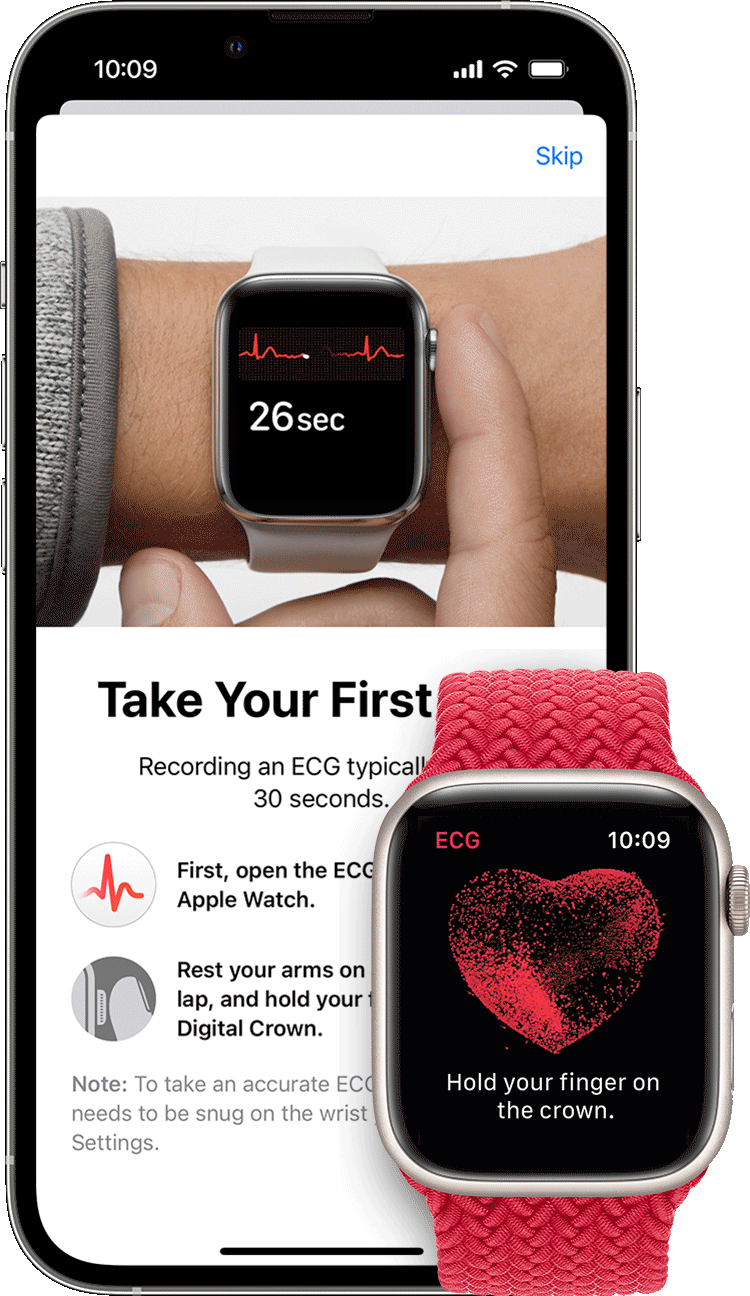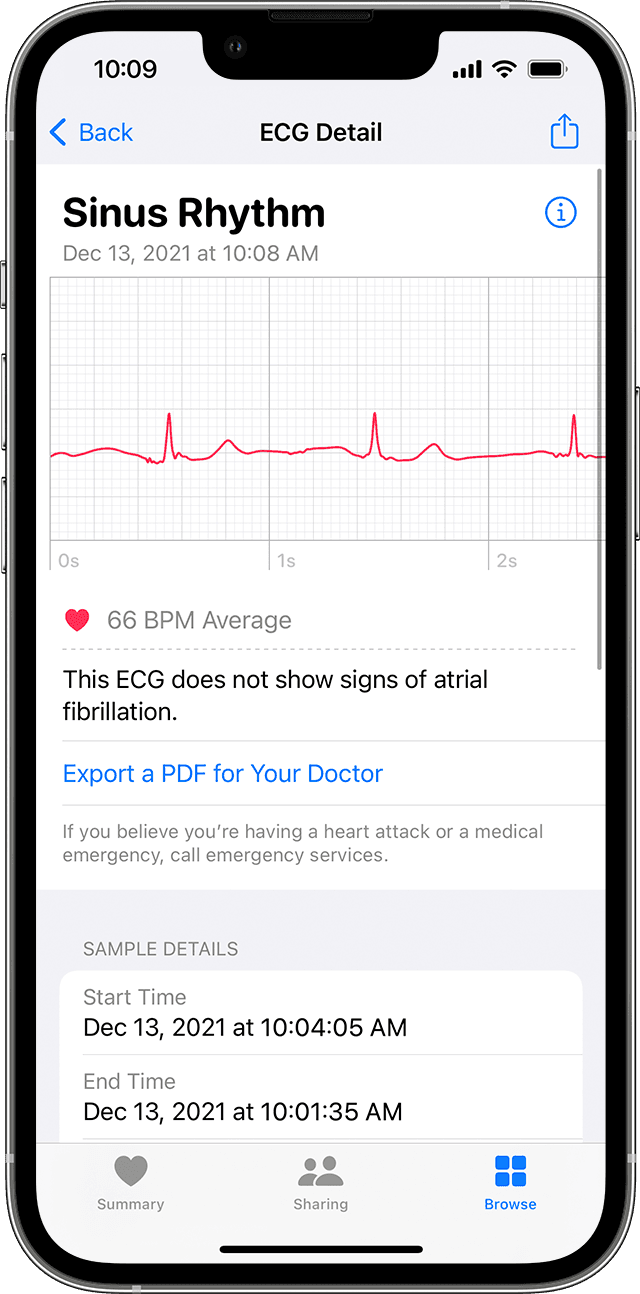Take an ECG with the ECG app on Apple Watch
You can take an electrocardiogram (ECG) with the ECG app.
What is an ECG?
An electrocardiogram (also called an ECG or EKG) is a test that records the timing and strength of the electrical signals that make the heart beat. By looking at an ECG, a doctor can gain insights about your heart rhythm and look for irregularities.
How to use the ECG app
The ECG app can record your heartbeat and rhythm using the electrical heart sensor on Apple Watch Series 4 or later and all models of Apple Watch Ultra* and then check the recording for atrial fibrillation (Afib), a form of irregular rhythm.
The ECG app records an electrocardiogram, which represents the electrical pulses that make your heart beat. The ECG app will check these pulses to take your heart rate and to see if the upper and lower chambers of your heart are in rhythm. If they're out of rhythm, this could be indicative of Afib.
Here’s what you’ll need
Make sure that the ECG app is available in your country or region. Find out where the ECG app is available.
Update your iPhone to the latest version of iOS and Apple Watch to the latest version of watchOS.
The ECG app is not intended to be used by people under the age of 22.
Install and set up the ECG app
The can be installed during the ECG app setup in the Health app. Follow these steps to set up the ECG app:
Open the Health app on your iPhone.
Follow the onscreen steps. If you don't receive a prompt to set up the ECG app, tap the Browse tab, then tap Heart > Electrocardiograms (ECG) > Set Up ECG App.

After you’ve finished setting it up, open the to take an ECG.
If you still can't see the app on your Apple Watch, open the Watch App on your iPhone and tap Heart. In the ECG section, tap Install to install the ECG app.
Take an ECG
You can take an ECG at any time — when you're experiencing symptoms, such as a rapid or skipped heartbeat, when you have other general concerns about the health of your heart or when you receive an irregular rhythm notification.

Make sure that your Apple Watch is fixed snugly on the wrist that you've selected in the Apple Watch app. To check, open the Apple Watch app, tap the My Watch tab, then go to General > Watch Orientation.
Open the on your Apple Watch.
Rest your arms on a table or on your lap.
Using your other hand (the one that doesn't have the Apple Watch on), hold your finger on the Digital Crown. You don't need to press the Digital Crown during the session.
Wait. It will take 30 seconds for the recording to be taken. At the end of the recording, you'll receive a classification. Then you can tap Add Symptoms and choose your symptoms.
Tap Save to note any symptoms, then tap Done.
How to read results
After a successful reading, you'll receive one of the following results on your ECG app. Regardless of the result, if you're not feeling well or if you're experiencing any symptoms, you should talk to your doctor.
Sinus rhythm
A sinus rhythm result means the heart is beating in a uniform pattern between 50 and 100 BPM. This happens when the upper and lower chambers of the heart are beating in sync. A sinus rhythm result only applies to that particular recording and doesn't mean that your heart beats with a consistent pattern all the time. It also doesn't mean that you're healthy. If you're not feeling well or if you're experiencing any symptoms, you should talk to your doctor.
Atrial fibrillation (Afib)
An Afib result means the heart is beating in an irregular pattern. Afib is the most common form of serious arrhythmia, or irregular heart rhythm. If you've received an Afib classification and haven't previously been diagnosed with Afib, you should talk to your doctor. The ECG app version 1 can check for Afib between 50 and 120 BPM. The ECG app version 2 can check for Afib between 50 and 150 BPM.
Find out more about ECG app version availability and find out which version you’re using.
Low or high heart rate
A heart rate under 50 BPM or over 120 BPM in ECG version 1 will affect the ECG app's ability to check for Afib. In ECG version 2, a heart rate under 50 BPM or over 150 BPM can affect the ECG app's ability to check for Afib.
A low heart rate can be caused by certain medication or if electrical signals are not being conducted correctly through the heart. Training to be an elite athlete can also lead to a low heart rate.
A high heart rate could be due to exercise, stress, nervousness, alcohol, dehydration, infection, Afib or other arrhythmias.
Inconclusive
An inconclusive result means the recording couldn't be classified. It may be due to one of the following situations:
In ECG version 1, your heart rate is between 100 and 120 BPM and you're not in Afib.
You have a pacemaker or implantable cardioverter defibrillator (ICD).
The recording may show signs of other arrhythmias or heart conditions that the app has not been designed to recognise.
Certain physiological conditions may prevent a small percentage of users from creating enough signal to produce a good recording.
For ECG version 1, you may also get an inconclusive result if you're not resting your arms on a table during a recording, or if you're wearing your Apple Watch too loosely. Find out how to get the best results.
Poor Recording
This classification is unique to ECG version 2. Poor Recording means the result couldn't be classified. If you've received a Poor Recording result, there are a few things you can try in order to get a better recording.
Rest your arms on a table or in your lap when you're taking a recording. Try to relax and not move too much.
Make sure that your Apple Watch isn't sitting too loosely on your wrist. The band should be snug and the back of your Apple Watch needs to be touching your wrist.
Make sure that your wrist and Apple Watch are clean and dry. Water and sweat can cause a poor recording.
Make sure that your Apple Watch is on the wrist you've selected in Settings.
Move away from any electrical devices that are plugged into a power socket to avoid electrical interference.
View and share your Health information
The ECG waveform, its associated classifications, and any noted symptoms will be saved in the Health app on your iPhone or iPad. You can also share a PDF with your doctor.

Open the Health app on your iPhone or iPad.
If you're on your iPhone, tap Browse. If you’re on your iPad, tap to open the .
Tap Heart, then tap Electrocardiograms (ECG).
Tap the chart for your ECG result.
Tap Export a PDF for Your Doctor.
Tap the to print or share the PDF.
How to get the best results
Rest your arms on a table or in your lap when you're taking a recording. Try to relax and not move too much.
Make sure that your Apple Watch isn't loose on your wrist. The band should be snug, and the back of your Apple Watch needs to be touching your wrist.
Make sure that your wrist and Apple Watch are clean and dry.
Make sure that your Apple Watch is on the wrist that you've selected in the Apple Watch app. To check, open the Apple Watch app, tap the My Watch tab, then go to General > Watch Orientation.
Move away from any electrical devices that are plugged into a power socket to avoid electrical interference.
A small percentage of people may have certain physiological conditions that prevent the creation of enough signal to produce a good recording — for example, the positioning of the heart in the chest can change the electrical signal levels, which can impact the ECG app's ability to obtain a measurement.
Liquid-free contact is required for the ECG app to work correctly. Use of the ECG app may be impacted if your Apple Watch and/or skin aren't entirely dry. Make sure that your wrist and hands are completely dry before attempting a reading. To ensure the best reading after swimming, showering, heavy perspiration or washing your hands, clean and dry your Apple Watch. It may take one hour or more for your Apple Watch to completely dry.
Things you should know
The ECG app cannot detect a heart attack. If you ever experience chest pain, pressure, tightness or what you think is a heart attack, call the emergency services immediately.
The ECG app cannot detect blood clots or a stroke.
The ECG app cannot detect other heart-related conditions. These include high blood pressure, congestive heart failure, high cholesterol or other forms of arrhythmia.
If you're not feeling well or if you're experiencing any symptoms, talk to your doctor or seek immediate medical attention.
How the ECG app works
The ECG app on Apple Watch Series 4 or later and all models of Apple Watch Ultra generates an ECG that is similar to a single-lead (or Lead I) ECG. In a medical setting, a standard 12-lead ECG will usually be taken. This 12-lead ECG records electrical signals from different angles in the heart to produce 12 different waveforms. The ECG app on Apple Watch can measure a waveform similar to one of those 12 waveforms. A single-lead ECG is able to provide information about heart rate and heart rhythm, and enables classification of Afib. However, a single-lead ECG cannot be used to identify some other conditions, such as heart attacks. Single-lead ECGs are often prescribed for people to wear at home or when they're in hospital so that the doctor can get a better look at the underlying rate and rhythm of the heart. However, the ECG app on Apple Watch Series 4 or later and all models of Apple Watch Ultra allows you to generate an ECG similar to a single-lead ECG without a prescription from your doctor.
In studies comparing the ECG app on Apple Watch with a standard 12-lead ECG taken at the same time, there was agreement between the ECG app classification of the rhythm as sinus or Afib when compared with the standard 12-lead ECG.
The ability of the ECG app to accurately classify an ECG recording into Afib and sinus rhythm was tested in a clinical trial of approximately 600 participants, and demonstrated 99.6% specificity with respect to sinus rhythm classification and 98.3% sensitivity for Afib classification for the classifiable results.
The clinical validation results reflect use in a controlled environment. Real-world use of the ECG app may result in a greater number of strips being deemed inconclusive and not classifiable.
Learn more
* The ECG app is not supported on Apple Watch SE or with Apple Watch For Your Kids.